Related Research Articles

Omphalotus olearius, commonly known as the jack-o'-lantern mushroom, is a poisonous orange gilled mushroom that to an untrained eye appears similar to some chanterelles. It is notable for its bioluminescent properties. It is found in woodland areas in Europe, where it grows on decaying stumps, on buried roots or at the base of hardwood trees. It has also been reported from the Western Cape Province, South Africa. A similar, but phylogenetically distinct species found in eastern North America is Omphalotus illudens.

The Boletaceae are a family of mushroom-forming fungi, primarily characterised by small pores on the spore-bearing hymenial surface, instead of gills as are found in most agarics. Nearly as widely distributed as the agarics, the family is renowned for hosting some prime edible species highly sought after by mushroom hunters worldwide, such as the cep or king bolete . A number of rare or threatened species are also present in the family, that have become the focus of increasing conservation concerns. As a whole, the typical members of the family are commonly known as boletes.

Pleurotus is a genus of gilled mushrooms which includes one of the most widely eaten mushrooms, P. ostreatus. Species of Pleurotus may be called oyster, abalone, or tree mushrooms, and are some of the most commonly cultivated edible mushrooms in the world. Pleurotus fungi have also been used in mycoremediation of pollutants, such as petroleum and polycyclic aromatic hydrocarbons.

Boletus is a genus of mushroom-producing fungi, comprising over 100 species. The genus Boletus was originally broadly defined and described by Carl Linnaeus in 1753, essentially containing all fungi with hymenial pores instead of gills. Since then, other genera have been defined gradually, such as Tylopilus by Petter Adolf Karsten in 1881, and old names such as Leccinum have been resurrected or redefined. Some mushrooms listed in older books as members of the genus have now been placed in separate genera. These include such as Boletus scaber, now Leccinum scabrum, Tylopilus felleus, Chalciporus piperatus and Suillus luteus. Most boletes have been found to be ectomycorrhizal fungi, which means that they form a mutualistic relationship with the roots system of certain kinds of plants. More recently, Boletus has been found to be massively polyphyletic, with only a small percentage of the over 300 species that have been assigned to Boletus actually belonging there and necessitating the description and resurrection of many more genera.
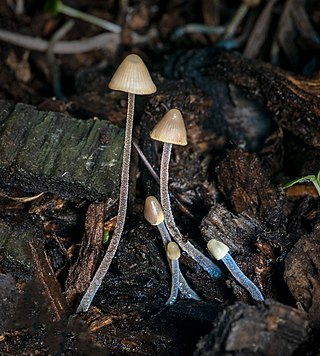
Mycena is a large genus of small saprotrophic mushrooms that are rarely more than a few centimeters in width. The name Mycena comes from the Ancient Greek μύκηςmykes, meaning "fungus". Species in the genus Mycena are commonly known as bonnets.

The Agaricomycetes are a class of fungi in the division Basidiomycota. The taxon is roughly identical to that defined for the Homobasidiomycetes by Hibbett & Thorn, with the inclusion of Auriculariales and Sebacinales. It includes not only mushroom-forming fungi, but also most species placed in the deprecated taxa Gasteromycetes and Homobasidiomycetes. Within the subdivision Agaricomycotina, which already excludes the smut and rust fungi, the Agaricomycetes can be further defined by the exclusion of the classes Tremellomycetes and Dacrymycetes, which are generally considered to be jelly fungi. However, a few former "jelly fungi", such as Auricularia, are classified in the Agaricomycetes. According to a 2008 estimate, Agaricomycetes include 17 orders, 100 families, 1147 genera, and about 21000 species. Modern molecular phylogenetic analyses have been since used to help define several new orders in the Agaricomycetes: Amylocorticiales, Jaapiales, Stereopsidales, and Lepidostromatales.
Harry Delbert Thiers was an American mycologist who studied and named many fungi native to North America, particularly California. Thiers taught mycology at San Francisco State University. He comprehensively revised and expanded on the North American collection of boletes and named many new species.
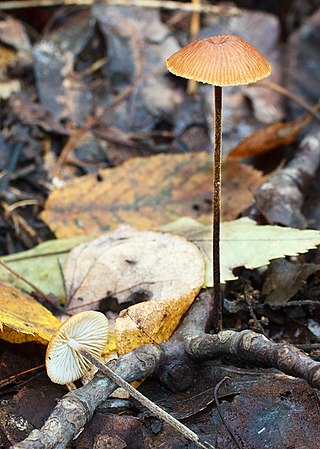
Rhizomarasmius is a genus of fungi in the family Physalacriaceae, containing about five species.

Mycena polygramma, commonly known as the grooved bonnet, is a species of mushroom in the family Mycenaceae. The inedible fruit bodies are small, pale gray-brown mushrooms with broadly conical caps, pinkish gills. They are found in small troops on stumps and branches of deciduous and occasionally coniferous trees. The mushroom is found in Asia, Europe, and North America, where it is typically found on twigs or buried wood, carrying out its role in the forest ecosystem by decomposing organic matter, recycling nutrients, and forming humus in the soil. M. polygramma contains two uncommon hydroxy fatty acids and is also a bioluminescent fungus whose intensity of light emission follows a diurnal pattern.

Panellus is a genus of more than 50 mushroom species of fungi in the family Mycenaceae as defined molecularly. Prior to molecular analyses the generic name had been used for any white-spored pleurotoid with amyloid spores. Unrelated but similar species are now classified in Sarcomyxa and Scytinotus. In older guides and other literature the type species had been placed in either Pleurotus or Panus and the poroid species had been classified in the synonymous genus Dictyopanus or in broadly defined genera like Polyporus (Polyporaceae) or the more closely allied Favolaschia (Mycenaceae). The closest molecular allies are Resinomycena and Cruentomycena.

Panellus stipticus, commonly known as the bitter oyster, the astringent panus, the luminescent panellus, or the stiptic fungus, is a species of fungus. It belongs in the family Mycenaceae, and the type species of the genus Panellus. A common and widely distributed species, it is found in Asia, Australia, Europe, and North America, where it grows in groups or dense overlapping clusters on the logs, stumps, and trunks of deciduous trees, especially beech, oak, and birch. During the development of the fruit bodies, the mushrooms start out as tiny white knobs, which, over a period of one to three months, develop into fan- or kidney-shaped caps that measure up to 3 cm (1.2 in) broad. The caps are orange-yellow to brownish, and attached to the decaying wood by short stubby stalks that are connected off-center or on the side of the caps. The fungus was given its current scientific name in 1879, but has been known by many names since French mycologist Jean Bulliard first described it as Agaricus stypticus in 1783. Molecular phylogenetic analysis revealed P. stipticus to have a close genetic relationship with members of the genus Mycena.
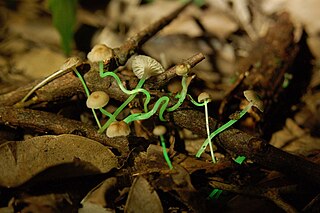
Mycena luxaeterna, commonly known as the eternal light mushroom, is a species of fungus in the family Mycenaceae. The mushrooms have parachute-shaped caps which start off darkly grayish-brown, changing to grayish-yellow or pale grayish-brown with a pale white ring at the edge when mature, and reach up to 2 cm (0.79 in) in diameter. Their thin, cylindrical, hollow, fragile stems up to 8 mm (0.31 in) in diameter are covered in a thick gel and emit a constant yellow-green bioluminescence. The gills are attached. The mushroom has a slightly radish-like smell and similar slightly bitter taste.
Neonothopanus gardneri, locally known as flor de coco, is a bioluminescent fungus native to Goiás, Piauí and Tocantins states in Brazil.
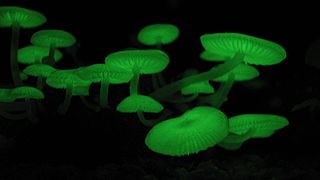
Mycena chlorophos is a species of agaric fungus in the family Mycenaceae. First described in 1860, the fungus is found in subtropical Asia, including India, Japan, Taiwan, Polynesia, Indonesia, and Sri Lanka, in Australia, and Brazil. Fruit bodies (mushrooms) have pale brownish-grey sticky caps up to 30 mm (1.2 in) in diameter atop stems 6–30 mm (0.2–1.2 in) long and up to a millimeter thick. The mushrooms are bioluminescent and emit a pale green light. Fruiting occurs in forests on fallen woody debris such as dead twigs, branches, and logs. The fungus can be made to grow and fruit in laboratory conditions, and the growth conditions affecting bioluminescence have been investigated.

Mycena singeri is a species of agaric fungus in the family Mycenaceae. Described as new to science in 1988 by Jean Lodge, it is bioluminescent. In 2007, the first reported luminescent species were found from a single site in primary Atlantic Forest habitat in the Alto Ribeira Tourist State Park, São Paulo State, Brazil.

Filoboletus manipularis is a species of agaric fungus in the family Mycenaceae. Found in Australasia, Malaysia, and the Pacific islands, the mycelium and fruit bodies of the fungus grow in forests and can be bioluminescent. The fruiting bodies also display a variety of morphologies that have no current genetic attributions. References to Filoboletus manipularis can be found in Japanese folklore and Indonesian food culture.
Mycena indigotica is a species of fungus. It was described for the first time in 2018 by Chia Ling Wei and Roland Kirschner after its discovery on the North-western Pacific Island of Taiwan. The genus Mycena is most famous for containing the majority of described bioluminescent fungi. However, M. indigotica is one of the many non-bioluminescent species within the genus. Nonetheless, this mushroom is aesthetically striking, with a petite and novel morphology.
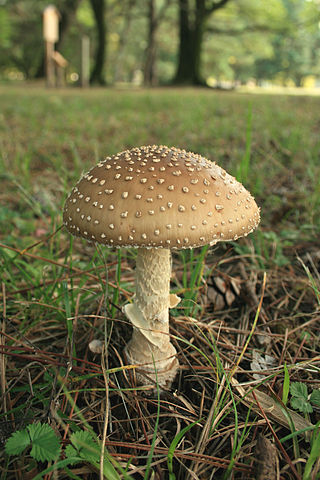
Symbiomycota is a clade of fungi containing both Glomeromycota and Dikarya. It is supported with RNA analysis.
References
- 1 2 McFarland, Cody (May 14, 2019). "'Mushroom guru of the West Coast' inspires students, imparts expertise". Golden Gate Xpress, The Student News Site of San Francisco State University.
- 1 2 3 4 5 "Dennis Edm Desjardin". SF State Faculty Sites.
- 1 2 3 4 "Our team of experts • Sempera Organics".
- ↑ "Dennis e. Desjardin | Department of Biology". San Francisco State University.
- ↑ Dentinger, Bryn T.M.; Ammirati, Joseph F.; Both, Ernst E.; Desjardin, Dennis E.; Halling, Roy E.; Henkel, Terry W.; Moreau, Pierre-Arthur; Nagasawa, Eiji; Soytong, Kasem; Taylor, Andy F.; Watling, Roy; Moncalvo, Jean-Marc; McLaughlin, David J. (2010). "Molecular phylogenetics of porcini mushrooms (Boletus section Boletus)". Molecular Phylogenetics and Evolution. 57 (3): 1276–1292. doi:10.1016/j.ympev.2010.10.004. PMID 20970511.
- ↑ Lodge, D. Jean; et al. (2014). "Molecular phylogeny, morphology, pigment chemistry and ecology in Hygrophoraceae (Agaricales)". Fungal Diversity. 64: 1–99. doi: 10.1007/s13225-013-0259-0 . hdl: 2318/136089 . S2CID 256064376.
- ↑ "Dennis Desjardin | SF State News". San Francisco State University.
- ↑ International Plant Names Index. Desjardin.